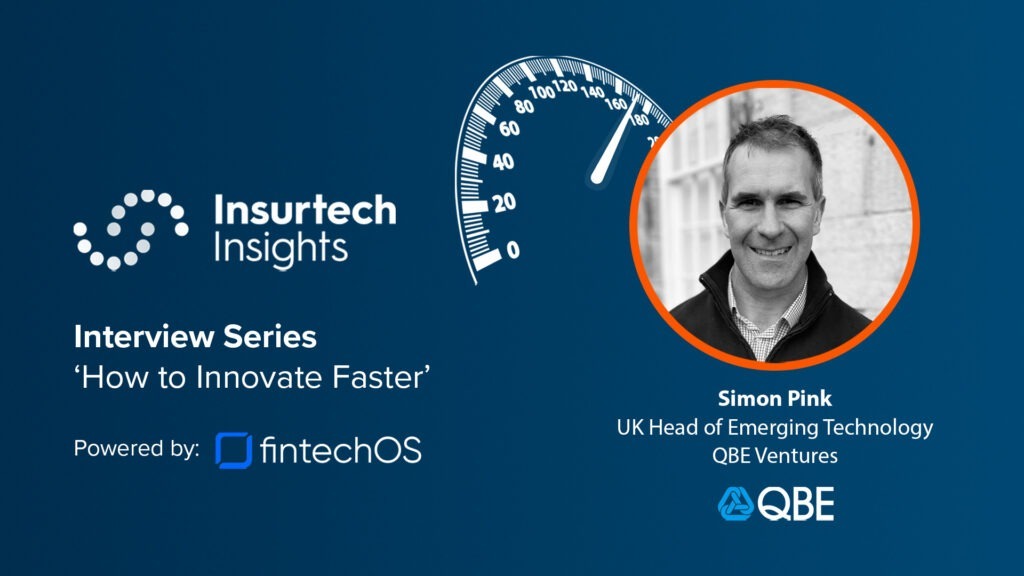The pace of innovation in the insurance industry has hit the gas pedal in recent years. The demand for digital transformation has been necessary for all companies relying on legacy systems and traditional processes, to survive and thrive in the midst of big social, geopolitical and economic changes.
But the adoption of new technologies, practices and strategies, is far from simple. Aside from the cost, every organisation has its own cultural challenges and needs to establish processes whereby new technologies can be assessed and implemented that will drive the business forward in the most efficient of ways, as well as preserving and enhancing the customer journey and overall experience.
Insurtech Insights has teamed up with FintechOS to bring our community a new series of interviews and articles from prominent leaders in the space, that highlight and provide information and guidance on successful innovation strategies.
This week, we spoke to Simon Pink, the UK Head of Emerging Technology for QBE Ventures, who is at the forefront of innovation from a value-driven perspective.
How does the pace of innovation in insurance compare with other industries?
Having spent most of my 25-year career working within banking I see a material difference in the pace and approach to innovation between both sectors. This is really a result of the nature of the sectors. Banks tend to own the customer from cradle to grave, they are able to collect and trust the information and data they build up on a customer and their wants and needs.
Insurance is a heavily dis-intermediated business with multiple parties in the value chain. This can result in multiple copies of data, manual rekeying into different systems, paper based claims can result in data and information inconsistencies throughout the engagement model. For technology and business model innovation to succeed it needs to be built on trusted data. Against this backdrop, to identify and validate the data to make a particular decision or build a new offering takes time.
What are the success factors required to achieve innovation, in your opinion?
Some of the table stakes for adopting new and innovative capabilities include:
- Board level sponsorship – An appointee, money and metrics on the adoption of innovative practices from across the business
- Laser focused on the business value – avoid innovation theatre by rapidly creating prototypes, experiments and examples for ideas that could have a positive impact on the business and or their customers. In other words, show not tell.
- A thin thread – don’t over scope the idea but do establish that thin thread that takes the idea from its inception to its first production deployment. This tests the ‘route to live’ and viability of the idea.
- Guardrails – from a common definition of what Innovation means to the business through to the people and processes to support through the journey to always check that as the idea matures it remains viable, valuable and desirable.
What are the cultural changes required to drive digital change within an organisation ?
To successfully sustain an innovation culture an organisation needs to reward a set of behaviours that could feel foreign to an industry built on managing risk. For example what I have seen work elsewhere includes a celebration of failure. This is where teams are encouraged to share within the business what they have learnt in equal measure from their successes and failures. This is brave but inspires others to help and the humility that comes with the open nature of this starts to change the corporate outlook to find solutions to do business better.
Secondly, flatten the organisational structure. A successful, innovative organisation will contain a diverse set of skills and experience from across every aspect of the business. This will include team members at different levels / grades / bands within an organisation. These organisational grades should quite literally be left at the door. The way to make this work is through constant communication, mutual respect and a growth mindset. We are all there to contribute and learn from each other.
What are the most important business goals that innovation supports?
This depends upon the strategy, goals and ambitions for each individual company. Some companies invest more in better supporting and retaining their customers, others in operational efficiency and cost reduction. Few do both successfully simultaneously. Innovation is truly in the eyes of the beholder. In my previous roles we supported clients who for their particular business and market place it was being able to leverage their data management better. For others it was experimenting with Blockchain and Internet of Things platforms to drive new business models. Every successful company needs to embrace an innovative mindset in order to survive.
How do you nurture and retain the right talent to ensure innovation successes?
Build a diverse, collaborative team. Innovation teams can quickly become isolated from the business. By creating an ‘Innovation assignment’ model early career professionals from across the business (not just technology) can be assigned to an innovation team for up to a year to contribute and drive the business innovation agenda as part of their own professional development and visibility to the company.
To what extent is technology a barrier/enabler to progress?
Technology can be an enabler of innovation but not the innovation in itself. Moore’s law has for generations demonstrated faster, cheaper, better technology. Today we are able to access massive amounts of computing resources and selection of tools from a few clicks on the mouse. There is a challenge with every organisation when it comes to integrating new services into their existing operation. The primary objective is a valuable and defined business outcome. Technology is and always should be an enabler to this.
How can we overcome technology barriers?
In building out the innovative concept then the most important thing to do is make sure that there is someone representing the technology delivery team around the whiteboard from the outset. In trying to establish if this can be standalone, fully integrated or a direct replacement there are a few key questions to consider:
- Where in our business workflow does this live?
- What are the skills and resources we have and need to design, deliver and maintain this solution?
- What is the minimal amount of input and output data we need for this concept to be valuable and succeed?
What are the best ways of overcoming barriers when it comes to data silos within an organisation?
There are new ways of accessing data from across the organisation. One option is the use of a data fabric that enables data to remain where it is (in those silos) and be able to query it from a central point. This is really powerful for the right use cases and really negates the need to centralise all the data to a data lake.
The biggest challenge we have as an industry is in the quality of our data in those silos. Unlike banking where banks can work with and collect data on their customers throughout their banking journey, insurance remains heavily disintermediated. The consequence is multiple copies of data, rekeying of information into multiple systems and the inherent inconsistencies and inaccuracies that this creates.
As we look to adopt more AI capabilities we will be beholden upon finding and nurturing the trusted sources of data. In the short term this will result in tightly controlled, relatively narrow use cases for the use of AI as a back office service engine as opposed to underpinning business model transformation.
About Simon Pink: Simon Pink is the UK Head of Emerging Technology for QBE Ventures. His role helps QBE Ventures to identify, invest in and partner with early stage companies that could be a strategic fit with the QBE business. Prior to this, he was a client technical advisor for IBM Financial Services and worked with some of IBM’s largest clients to help them understand, test and adopt new and emerging technologies into their business. We caught up with him to find out more.









